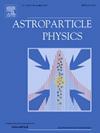三维星系气体结构对宇宙射线输运和γ射线发射的影响
IF 2.9
3区 物理与天体物理
Q1 ASTRONOMY & ASTROPHYSICS
引用次数: 0
摘要
宇宙射线(CRs)在星际介质(ISM)动力学中起着重要作用。它们的相互作用和输运电离、加热并推动ISM,从而使ISM的不同区域耦合。CRs的空间分布取决于其源的分布以及与之相互作用的ISM成分,如气体、星光和磁场。特别是,气体影响CR通量和γ射线发射。通过使用PICARD代码和最近的HI和H2星系气体成分三维重建的多个样本研究它们之间的相关性,我们说明了现实的和很大程度上结构化的三维气体分布对CR输运和γ射线发射的影响。我们调整了扩散系数Dxx和alfv本文章由计算机程序翻译,如有差异,请以英文原文为准。
The influence of the 3D Galactic gas structure on cosmic-ray transport and γ-ray emission
Cosmic rays (CRs) play a major role in the dynamics of the interstellar medium (ISM). Their interactions and transport ionize, heat, and push the ISM thereby coupling different regions of it. The spatial distribution of CRs depends on the distribution of their sources as well as the ISM constituents they interact with, such as gas, starlight, and magnetic fields. Particularly, gas influences CR fluxes and -ray emission. We illustrate the influence of realistic and largely structured 3D gas distributions on CR transport and -ray emission, by studying their correlation using the PICARD code and multiple samples of recent 3D reconstructions of the HI and H2 Galactic gas constituents. We adjust the diffusion coefficient and Alfvén speed to reproduce local measurements of B/C abundances and find that these parameters depend non-linearly on the local distribution of gas. When simulating CR transport, the distributions of CR fluxes exhibit energy-dependent structures that vary for all CR species due to their corresponding loss processes. Regions of enhanced secondary (primary) species are spatially correlated (anti-correlated) with the gas density. Furthermore, we show that the morphology of gas clouds alone impacts CR flux predictions. For -ray emission, we observe a high sensitivity of the -ray emissivities to gas structures, as these determine the spatial distributions of hadronic interactions and bremsstrahlung. This way, we have for the first time calculated how well-defined uncertainties in a structured gas model propagate to CR transport and -ray emission.
求助全文
通过发布文献求助,成功后即可免费获取论文全文。
去求助
来源期刊

Astroparticle Physics
地学天文-天文与天体物理
CiteScore
8.00
自引率
2.90%
发文量
41
审稿时长
79 days
期刊介绍:
Astroparticle Physics publishes experimental and theoretical research papers in the interacting fields of Cosmic Ray Physics, Astronomy and Astrophysics, Cosmology and Particle Physics focusing on new developments in the following areas: High-energy cosmic-ray physics and astrophysics; Particle cosmology; Particle astrophysics; Related astrophysics: supernova, AGN, cosmic abundances, dark matter etc.; Gravitational waves; High-energy, VHE and UHE gamma-ray astronomy; High- and low-energy neutrino astronomy; Instrumentation and detector developments related to the above-mentioned fields.
 求助内容:
求助内容: 应助结果提醒方式:
应助结果提醒方式:


